What is Flat Foot/Pes Planus?
Most people have a gap under the arch of the foot when they are standing. The arc, the inner part of the foot is slightly raised off the ground. People with flat foot or fallen arch either have no arch, or it is low. The foot of people with fallen arch may roll over the inner side when they are standing or walking, known as over pronation. The foot may point outward.
Normally, the tendons in the foot pull together the proper amount in order to maintain an arch when standing allowing for an even distribution of body weight, but for those with flat feet, the tendons do not pull together properly resulting in little to no arch and body weight being shifted to the inside of the foot.
In person with fallen arches, one or both feet may be flat on the ground, and shoes may wear unevenly, especially on one side, or they may wear out more quickly than usual.

Source : http://www.myfootclinic.com/flat-foot
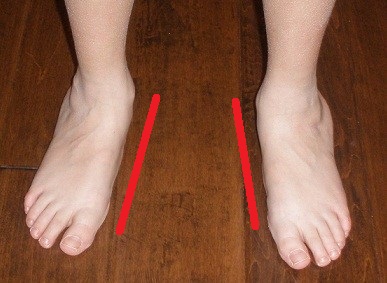 |
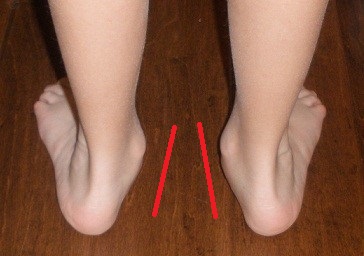 |
Body weight being shifted to the inside of the foot
Source : https://www.footeducation.com
What are the causes of Flat foot and fallen arch?
Causes of flat foot include:
- Inherited tendency to have flat foot
- Problems with foot bones developing before birth
- Connective tissue loose from conditions like joint hypermobility syndrome
- Nerve or muscle conditions such as cerebral palsy
- Damage or injury to connective tissue from ageing, overuse, injuries, obesity, rheumatoid arthritisor wearing shoes that don’t support the feet well.
Other factors that can increase your risk include:
- Obesity
- Diabetes
- Aging
- Pregnancy
What are the signs and symptoms of flat foot and fallen arch?
Flat foot may not cause any problems for some people, but symptoms can include:
- Foot and ankle pain, leg, knee, hip or back pain
- Foot pointing inwards (overpronation) leading to injuries and shoes wearing out sooner than expected
- Weakness, numbness or stiff foot.
What are the diagnosis for flat foot and fallen arch?
A doctor will diagnose flat foot based on the symptoms, medical history and a physical examination. A referral may be made to a podiatrist or orthopaedic surgeon to confirm the diagnosis and to consider possible treatments.
Further tests may be carried out, including:
- Checking shoe soles for wear
- Watching while basic standing and standing on tip toes are performed
- X-rays or an MRI scan of the feet.
Complications of flat foot or fallen arch
Examples include:
- Achilles tendinitis
- Arthritis in the ankle
- Arthritis in the foot
- Bunions
- Hammertoes
- Plantar fasciitis, where pain and inflammation occur in the ligaments in the soles of the feet
- Posterior tibial tendinitis
- Shin splints
Surgery for flat foot and fallen arches
If basic treatment is not helping problems caused by flat foot, surgery may be recommended. This will depend on the causes and individual circumstances. Operations or procedures may include separating or straightening bone abnormalities. Repair or lengthening of connective tissue may also be considered
Preventing flat foot
Flat foot cannot always be prevented, but staying healthy and choosing good quality supportive shoes can help avoid some problems developing.
How can Physiotherapy help?
Physiotherapy will help to: Regain movement / mobility of the foot Strengthen the surrounding muscles Regain foot and ankle control Provide initial relief of pain by using ice pack wrapped in a damp towel and placed on the foot or area of pain for 10-15 minute can help to reduce soreness. Some patients prefer moist heat for pain relief.
What is the physiotherapy management for Flat Foot?
1. Modalities
Heat and cold therapy is applied to enhance relaxation and reduces pain. It is important to use ice after exercise and after any activity that causes discomfort. Ultra sound and pulsed electrical stimulation can also be used to relieve the pain. Electric stimulation will helps to improve the blood circulation, thus enhancing the healing process and reducing any swelling or discomfort.
2. Exercise
Exercises will ease foot discomfort and restore function. It is normal to feel some discomfort, aching or stretching when performing exercises
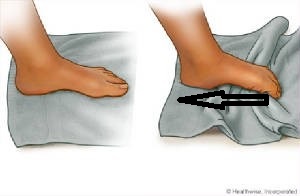 |
| Fig.1 : Toe Clawing Exercises : The toes of the foot are flexed fully; hold in that position and then release again…extend them fully. Repeat 10-15 times, 3x daily |
| Fig.1. Source: http://www.medicalcrafters.com/id78.html |
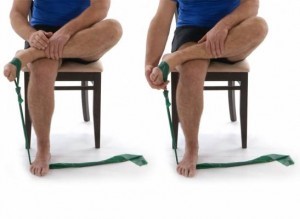 |
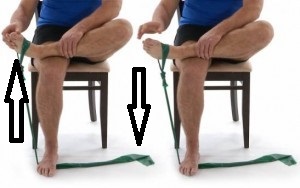 |
|
Fig.2. Arch muscle strength exercise: Sit down and cross your involved foot over the other thigh. |
| Fig.2. Source : http://www.medicalcrafters.com/id78.html |
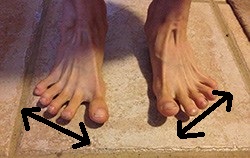 |
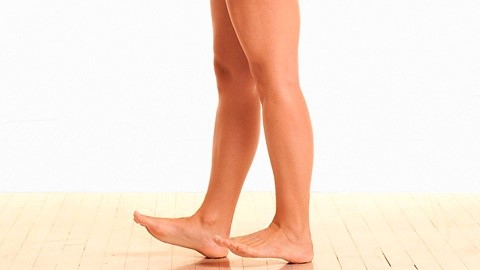 |
|
Fig. 3. Toe Spreading Exercise : The toes of the foot spread fully; hold in that position and then release. Repeat 10-15 times, 3x daily |
Fig.4. Heel Walking exercise |
|
Fig.3. Source: https://houstonfootankle.com/2016/09/five-exercises-for-fit-feet/ |
Fig.4. Source: https://www.thecoachsmith.com/balance-strength-exercises/ |
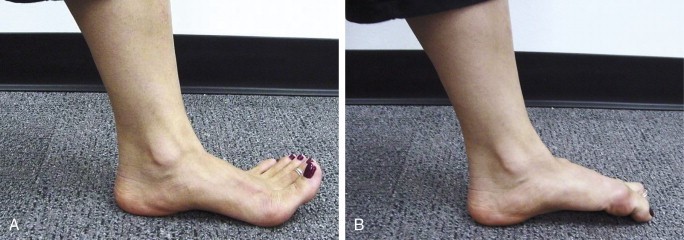 |
|
Fig 5 : (A) Fully extend the toes then (B) fully bend the toes to make a fist, Repeat 10-15 times, 3x daily |
| Fig.5. Source : http://www.sciencedirect.com/topics/page/Flexor_digitorum_longus_muscle |
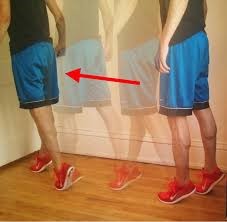 |
| Fig. 6. Toe walking exercises |
| Fig.6. Source : https://runnersconnect.net/posterior-tibial-tendonitis/ |
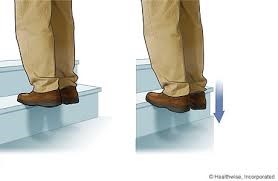 |
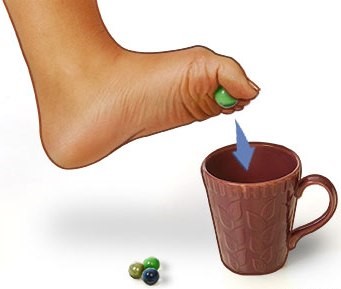 |
|
Fig.5. Stand up on a step, placing only your forefeet on it. Lower your heels until you feel a stretch in your calves. hold in that position and then release. Repeat 10-15 times, 3x daily |
Fig.6; Gripping exercise: Toes grip together to pick up marbles. Repeat 10-15 times, 3x daily |
|
Fig.5. Source: http://www.webmd.com/fitness-exercise/stretch-plantar-fascia-and-calf |
Fig.6. Source: http://runnerclick.com/plantar-fasciitis-exercises/ |
Examples: Supports for Flat foot/fallen arch
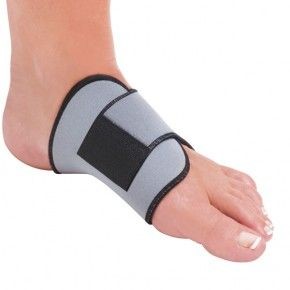 |
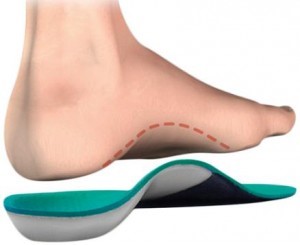 |
| Source : https://www.pinterest.com/fallen arch | Source: http://bestwalkingfeet.com/good- shoes-for-flat-feet/insoles-and-inserts/ |
Test Yourself for Flat Feet
You can easily test yourself to see if you might have fallen arches or flat feet. Follow these three steps:
- Get your feet wet.
- Stand on a flat surface where your footprint will show, such as on a concrete walkway.
- Step away and look at the prints. If you see complete imprints of the bottom of your feet on the surface, then you’re likely to have flat feet.
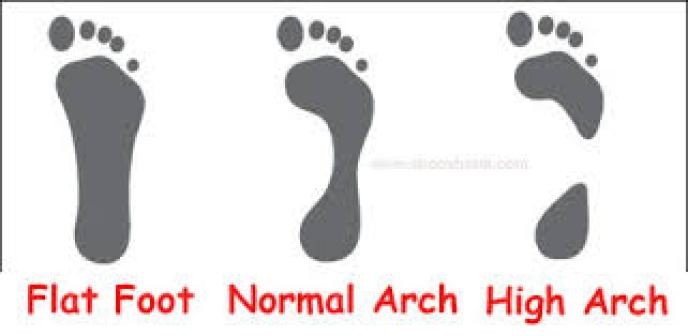
Source : https://footcareguru.com/best-shoes-for-flat-feet/
Many young children have flat feet, a condition referred to as flexible flat feet. When the child stands, the feet look flat. But when the child rises to his or her toes, a slight arch appears. In most cases, as children grow older, the arches develop.
References
- The British Orthopaedic Foot and Ankle Society: Flat feet.
- American Academy of Orthopaedic Surgeons: “Adult (Acquired) Flatfoot,” “Flexible Flatfoot in Children,” “Posterior Tibial Tendon Dysfunction” and “Rheumatoid Arthritis of the Foot and Ankle.”
- Snyder, K. Medscape/Applied Radiology Online: “Flat Feet.”
- eMedcine: “Acquired Flatfoot.”
- Matthew Buchanan, MD, Orthopedic Foot and Ankle Surgery, American Academy of Orthopaedic Surgeons
- WebMD Medical Reference Reviewed by David T. Derrer, MD
Source image
- http://www.myfootclinic.com/flat-foot / Retrieved May 21, 2017
- https://www.footeducation.com / Retrived May 21, 2017
- http://www.medicalcrafters.com/id78.html / Retrived May 21, 2017
- https://footcareguru.com/best-shoes-for-flat-feet/Retrived May 21, 2017
- https://houstonfootankle.com/2016/09/five-exercises-for-fit-feet/ Retrived May 22,2017
- https://www.thecoachsmith.com/balance-strength-exercises/ Retrived May 22,2017
- http://www.sciencedirect.com/topics/page/Flexor_digitorum_longus_muscle/ Retrived May 23, 2017
- http://www.webmd.com/fitness-exercise/stretch-plantar-fascia-and-calf/ Retrived May 24, 2017
- http://runnerclick.com/plantar-fasciitis-exercises/ Retrived May 24, 2017
- https://www.pinterest.com/fallen arch / Retrived May 24, 2017
- http://bestwalkingfeet.com/good- shoes-for-flat-feet/insoles-and-inserts/Retrived May 24, 2017
- https://runnersconnect.net/posterior-tibial-tendonitis/ Retrived May 25, 2017
| Last Reviewed | : | 23 August 2019 |
| Writer / Translator | : | Halimah bt. Hashim |
| Accreditor | : | Se To Phui Lin |
| Reviewer | : | Halimah bt. Hashim |







